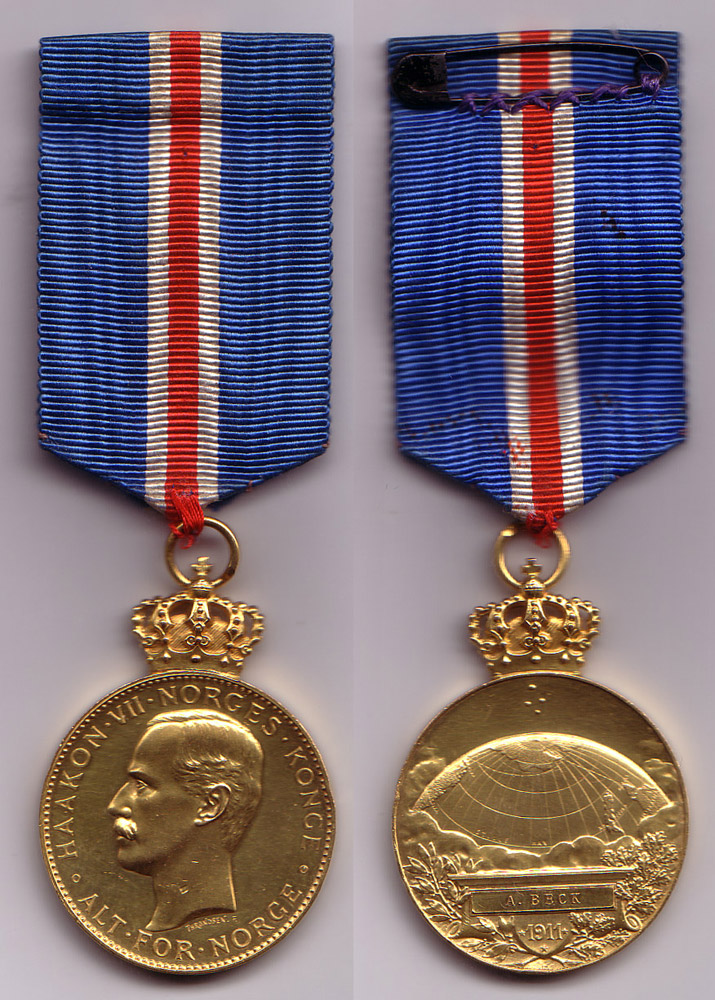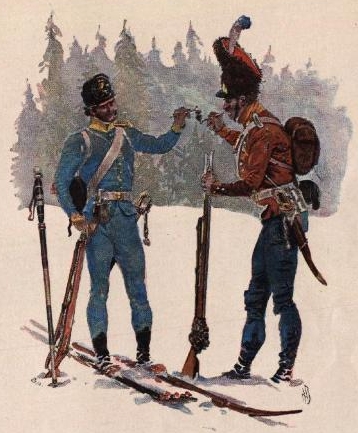|
King Haakon VII Commemorative Medal
The King Haakon VII Commemorative Medal of October 1, 1957 ( no, Kong Haakon VIIs minnemedalje 1. oktober 1957) is a Norwegian award created to commemorate the deceased monarch on the occasion of his funeral. King Haakon's funeral took place on October 1, 1957. The medal ranks 30th in the Norwegian decoration order of precedence. Description The medal is made of gold or silver, and the obverse depicts King Haakon VII. The king is depicted without his crown in an image created by the engraver Ivar Throndsen.H. M. Kong Haakon VII's erindringsmedalje med spenne 1. oktober 1957. 1960. ''Nordisk Numismatisk Unions Medlemsblad'' 10: 199. The portrait is surrounded by the inscription "HAAKON • VII • NORGES • KONGE •" (Haakon VII King of Norway). The reverse shows the royal monogram. The medal is fitted to a royal crown and hangs from a red medal ribbon. The medal ribbon has a silver clasp reading "1. OKTOBER 1957" (October 1, 1957).Hallberg, Harald. 2012. ''Norske dekorasjone ... [...More Info...] [...Related Items...] OR: [Wikipedia] [Google] [Baidu] |
Royal House Centennial Medal
The Royal House Centennial Medal ( no, Kongehusets 100-årsmedalje) is a Norwegian award established by Harald V of Norway to commemorate the centennial of the Norwegian Royal Family. The day that it was established marks the hundredth anniversary of the day that Haakon VII arrived in Norway: November 25, 1905. The medal ranks 29th in the Norwegian decoration order of precedence. Description The Royal House Centennial Medal is made of silver. It is round and has a diameter of 30 cm, with a royal crown fixed to the top. The obverse depicts King Haakon VII with the inscription "KONGEHUSET 100 ÅR" (The Royal House 100 Years). The reverse shows a wreath made of oak leaves. Above the wreath is the inscription "ALT FOR NORGE" (Everything for Norway), the motto of King Haakon VII, King Olav V, and King Harald V. Below the wreath is the inscription "1905–2005." The medal hangs from a blue ribbon with red and white edges, representing the colors of the Norwegian flag. The same color ... [...More Info...] [...Related Items...] OR: [Wikipedia] [Google] [Baidu] |
King Haakon VII 1905–1930 Jubilee Medal
The King Haakon VII 1905–1930 Jubilee Medal ( no, Kong Haakon VIIs jubileumsmedalje 1905–1930), also known as the King's Jubilee Medal ( no, Kongens jubileumsmedalje), is a Norwegian award instituted in 1930 by Haakon VII of Norway in honor of the 25th anniversary of his accession to the throne. The medal has been conferred upon 397 people.Hallberg, Harald. 2012. ''Norske dekorasjoner. Tildelt med bånd til å bæres på uniform eller sivilt antrekk.'' Ålgård: Dreyer bok, p. 235. Description The King Haakon VII 1905–1930 Jubilee Medal is made of silver and is 33 mm in diameter. The obverse depicts King Haakon VII with the inscription "HAAKON • VII • NORGES • KONGE •" (Haakon VII King of Norway). The reverse shows the royal monogram. The medal was created by the engraver Ivar Throndsen. The medal is fitted to a royal crown and hangs from a red medal ribbon. The medal ribbon has a silver clasp reading "1905–1930." Later the King Haakon VII 1905–1955 Ju ... [...More Info...] [...Related Items...] OR: [Wikipedia] [Google] [Baidu] |
Orders, Decorations, And Medals Of Norway
This is a list of Norwegian orders and medals, in order of precedence. This list contains all medals approved for wearing on a Norwegian military uniform in ranked order. Group 1: Awarded by or approved by H.M. The King Those awards presented by or approved by the Monarchy of Norway, King of Norway are worn in an order of precedence established by Royal Decree of 11 June 1943, with subsequent additions. Royal Family Orders * Royal Family Order of King Haakon VII of Norway (1906–1957) * Royal Family Order of King Olav V of Norway (1957–1991) * Royal Family Order of King Harald V of Norway (1991–current) These are not worn on military uniform. Group 2: Foreign state decorations Decorations that are awarded or approved by foreign heads of state. They are ranked as follows: British, Danish, Finnish, Icelandic, Swedish, other countries are ranked alphabetically by their name in French. Group 3: Decorations of UN, NATO, EU, OSCE and similar Decorations from intern ... [...More Info...] [...Related Items...] OR: [Wikipedia] [Google] [Baidu] |
Haakon VII Of Norway
Haakon VII (; born Prince Carl of Denmark; 3 August 187221 September 1957) was the King of Norway from November 1905 until his death in September 1957. Originally a Danish prince, he was born in Copenhagen as the son of the future Frederick VIII of Denmark and Louise of Sweden. Prince Carl was educated at the Royal Danish Naval Academy and served in the Royal Danish Navy. After the 1905 dissolution of the union between Sweden and Norway, Prince Carl was offered the Norwegian crown. Following a November plebiscite, he accepted the offer and was formally elected King of Norway by the Storting. He took the Old Norse name ''Haakon'' and ascended to the throne as Haakon VII, becoming the first independent Norwegian monarch since 1387. As king, Haakon gained much sympathy from the Norwegian people. Although the Constitution of Norway vests the King with considerable executive powers, in practice Haakon confined himself to non-partisan roles without interfering in politics, a pra ... [...More Info...] [...Related Items...] OR: [Wikipedia] [Google] [Baidu] |
Ivar Throndsen
Ivar Throndsen (March 29, 1853 – January 18, 1932) was a Norwegian engraver. Throndsen was born in Nes, Akershus. He became an apprentice to the goldsmith Jacob Tostrup in Christiania (now Oslo) in 1870, and at the same time studied at the Norwegian National Academy of Craft and Art Industry under the sculptor Julius Middelthun. He received a job at the Royal Norwegian Mint in Kongsberg in 1879 and, after finishing his studies, started working there in 1880. He produced nearly 500 medals, tokens, and badges during his career. Throndsen died in Kongsberg. His work was catalogued by Ragnar Støren and Hans Holst in 1937.Støren, Ragnar & Hans Holst. 1937. ''Myntgravør Ivar Throndsens medaljer, jetonger og merker''. Oslo: I kommisjon hos H. Aschehoug. Selected works * H. M. The King's Commemorative Medal * H. M. The King's Gold Medal * South Pole Medal * Norwegian Constitution Day medals, 1884–1920 * 1902 Nobel Peace Prize Medal based on a model by the sculptor Gustav Vig ... [...More Info...] [...Related Items...] OR: [Wikipedia] [Google] [Baidu] |
Norwegian Army
The Norwegian Army ( no, Hæren) is the land warfare service branch of the Norwegian Armed Forces. The Army is the oldest of the Norwegian service branches, established as a modern military organization under the command of the King of Norway in 1628. The Army participated in various continental wars during the 17th, 18th, and 19th centuries as well, both in Norway and abroad, especially in World War II (1939–1945). It constitutes part of the Norwegian military contribution as a charter member of the North Atlantic Treaty Organization (NATO) since 1949. History Creation of the Norwegian Army After the Kalmar War broke out in 1611, the Danish-Norwegian king, Christian IV tried to revive the leidang, with dire results. As the Norwegian peasantry had not been armed or trained in the use of arms for nearly three centuries, they were not able to fight. Soldiers deserted or were captured. The soldiers had to participate in military drills, while providing supplementary labor to ... [...More Info...] [...Related Items...] OR: [Wikipedia] [Google] [Baidu] |
Royal Norwegian Navy
The Royal Norwegian Navy ( no, Sjøforsvaret, , Sea defence) is the branch of the Norwegian Armed Forces responsible for naval operations of Norway. , the Royal Norwegian Navy consists of approximately 3,700 personnel (9,450 in mobilized state, 32,000 when fully mobilized) and 70 vessels, including 4 heavy frigates, 6 submarines, 14 patrol boats, 4 minesweepers, 4 minehunters, 1 mine detection vessel, 4 support vessels and 2 training vessels. It also includes the Coast Guard. This navy has a history dating back to 955. From 1509 to 1814, it formed part of the navy of Denmark-Norway, also referred to as the "Common Fleet". Since 1814, the Royal Norwegian Navy has again existed as a separate navy. In Norwegian, all its naval vessels since 1946 bear ship prefix "KNM", Kongelig Norske Marine (which accurately translates to Royal Norwegian Navy/Naval vessel). In English, they are permitted still to be ascribed prefix "HNoMS", meaning "His/Her Norwegian Majesty's Ship" ("HNMS" could b ... [...More Info...] [...Related Items...] OR: [Wikipedia] [Google] [Baidu] |
Royal Norwegian Air Force
The Royal Norwegian Air Force (RNoAF) ( no, Luftforsvaret, , The Air Defence) is the air force of Norway. It was established as a separate arm of the Norwegian Armed Forces on 10 November 1944. The RNoAF's peacetime establishment is approximately 2,430 employees (officers, enlisted staff and civilians). 600 personnel also serve their draft period in the RNoAF. After mobilization, the RNoAF would consist of approximately 5,500 personnel. The infrastructure of the RNoAF includes seven airbases (at Ørland, Rygge, Andøya, Evenes, Bardufoss, Bodø and Gardermoen), one control and reporting centre (at Sørreisa) and three training centres at Værnes in Stjørdal, 32.7 km north of Trondheim, where Trondheim airport now lies, Kjevik in Kristiansand and at KNM Harald Haarfagre/ Madlaleiren in Stavanger. History Conception Military flights started on 1 June 1912. The first plane, , was bought with money donated by the public and piloted by Hans Dons, second in command of Norway's f ... [...More Info...] [...Related Items...] OR: [Wikipedia] [Google] [Baidu] |
Norwegian Monarchy
Norwegian, Norwayan, or Norsk may refer to: *Something of, from, or related to Norway, a country in northwestern Europe *Norwegians, both a nation and an ethnic group native to Norway *Demographics of Norway *The Norwegian language, including the two official written forms: **Bokmål, literally "book language", used by 85–90% of the population of Norway **Nynorsk, literally "New Norwegian", used by 10–15% of the population of Norway *The Norwegian Sea Norwegian or may also refer to: Norwegian *Norwegian Air Shuttle, an airline, trading as Norwegian **Norwegian Long Haul, a defunct subsidiary of Norwegian Air Shuttle, flying long-haul flights *Norwegian Air Lines, a former airline, merged with Scandinavian Airlines in 1951 *Norwegian coupling, used for narrow-gauge railways *Norwegian Cruise Line, a cruise line *Norwegian Elkhound, a canine breed. *Norwegian Forest cat, a domestic feline breed *Norwegian Red, a breed of dairy cattle *Norwegian Township, Schuylkill County, ... [...More Info...] [...Related Items...] OR: [Wikipedia] [Google] [Baidu] |
Awards Established In 1957
An award, sometimes called a distinction, is something given to a recipient as a token of recognition of excellence in a certain field. When the token is a medal, ribbon or other item designed for wearing, it is known as a decoration. An award may be described by three aspects: 1) who is given 2) what 3) by whom, all varying according to purpose. The recipient is often to a single person, such as a student or athlete, or a representative of a group of people, be it an organisation, a sports team or a whole country. The award item may be a decoration, that is an insignia suitable for wearing, such as a medal, badge, or rosette (award). It can also be a token object such as certificate, diploma, championship belt, trophy, or plaque. The award may also be or be accompanied by a title of honor, as well as an object of direct value such as prize money or a scholarship. Furthermore, an honorable mention is an award given, typically in education, that does not confer the recipien ... [...More Info...] [...Related Items...] OR: [Wikipedia] [Google] [Baidu] |

.jpg)


